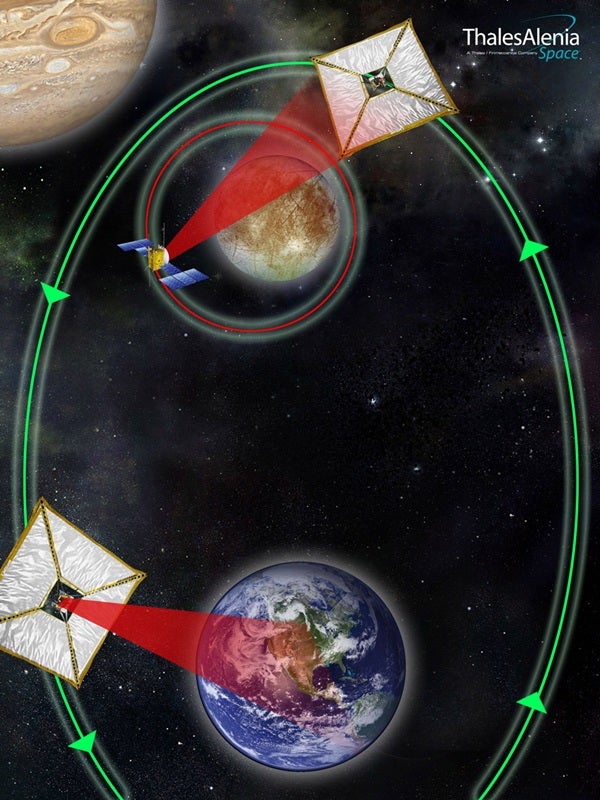A new golden age of sailing may be about to begin — in space. Future missions to explore the outer planets could employ fleets of “data clippers,” maneuverable spacecraft equipped with solar sails, to ship vast quantities of scientific data back to Earth.
According to Joel Poncy of Thales Alenia Space, the technology could be ready in time to support midterm missions to the moons of Jupiter and Saturn. Poncy presented an assessment of data clippers at the European Planetary Science Congress (EPSC) in Rome, Italy, September 20.
“Space-rated flash memories will soon be able to store the huge quantities of data needed for the global mapping of planetary bodies in high resolution,” said Poncy. “But a full high-res map of, say, Europa or Titan, would take several decades to download from a traditional orbiter, even using very large antennae. Downloading data is the major design driver for interplanetary missions. We think that data clippers would be a very efficient way of overcoming this bottleneck.
Poncy and his team at Thales Alenia Space have carried out a preliminary assessment for a data clipper mission. Their concept is for a clipper to fly close to a planetary orbiter, upload its data and fly by Earth, at which point terabytes of data could be downloaded to the ground station. A fleet of data clippers cruising around the solar system could provide support for an entire suite of planetary missions.
“We have looked at the challenges of a data clipper mission, and we think that it could be ready for a launch in the late 2020s,” Poncy said. “This means that the technology should be included now in the roadmap for future missions, and this is why we are presenting this study at EPSC.”
Poncy’s team have assessed the communications systems and tracking devices that a data clipper would need, as well as the flyby conditions and pointing accuracy required for the massive data transfers. Recent advances in technology mean that spacecraft propelled by solar sails, which use radiation pressure from photons emitted by the Sun, or electric sails, which harness the momentum of the solar wind, can now be envisaged for midterm missions. The Japanese Space Agency, JAXA, is currently testing a solar sail mission, IKAROS.
“Using the Sun as a propulsion source has the considerable advantage of requiring no propellant on board,” Poncy said. “As long as the hardware doesn’t age too much and the spacecraft is maneuverable, the duration of the mission can be very long. The use of data clippers could lead to a valuable downsizing of exploration missions and lower ground operation costs — combined with a huge science return. The orbiting spacecraft would still download some samples of their data directly to Earth to enable real-time discoveries and interactive mission operations. But the bulk of the data is less urgent and is often processed by scientists much later. Data clippers could provide an economy delivery service from the outer solar system, over and over again.
The king of planets dominates the sky
NASA’s LRO exposes the Moon’s complex, turbulent youth
3-D computer simulations help scientists envision supernova explosions
NASA’s lunar spacecraft completes exploration mission phase
Chandra finds evidence for stellar cannibalism
Hubble data harvests distant solar system objects










